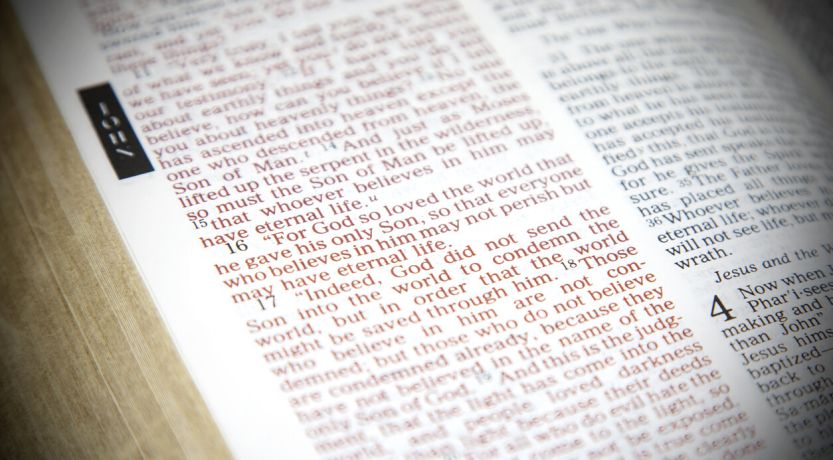Exploring the context of the most famous verse in the Bible can bring some surprises. What does a bronze serpent have to do with Jesus Christ?

The mysterious name Nehushtan appears once in the Bible, at the time of righteous King Hezekiah. But its story goes back to the time of Moses, and forward to the words of Jesus Christ Himself.
What does Nehushtan—“Bronze Thing” (New King James Version margin)—have to do with Jesus Christ’s crucifixion and the most famous verse in the Bible?
The mystique of John 3:16
John 3:16 is probably the most famous verse in the Bible.
According to Wikipedia:
- John 3:16 has been among the 10 most-searched verses on BibleGateway.com.
- The 16th-century Protestant theologian Martin Luther called the verse “the gospel in miniature.”
- Tim Tebow wrote John 3:16 on the eye black under his eyes during the 2009 BCS National Championship Game. This made it the most popular search phrase for more than a day.
- John 3:16 has been printed on Forever 21 shopping bags and on In-N-Out Burger paper cups.
But how many people actually think about the context in which Jesus said this famous verse? In the earlier verses Jesus referred back to one of the strangest stories during Israel’s wandering in the wilderness.
The context of John 3:16
Let’s look at John 3:14-16:
“And as Moses lifted up the serpent in the wilderness, even so must the Son of Man be lifted up, that whoever believes in Him should not perish but have eternal life.
“For God so loved the world that He gave His only begotten Son, that whoever believes in Him should not perish but have everlasting life.”
What’s this serpent that Moses lifted up? What was Jesus talking about?
This is a reference to what is called Nehushtan in 2 Kings 18:4.
The history of Nehushtan in the Bible
Jesus was specifically referring to Numbers 21, when Israel was wandering in the wilderness before coming to the Promised Land. Verses 4-5 say:
“Then they journeyed from Mount Hor by the Way of the Red Sea, to go around the land of Edom; and the soul of the people became very discouraged on the way.
“And the people spoke against God and against Moses: ‘Why have you brought us up out of Egypt to die in the wilderness? For there is no food and no water, and our soul loathes this worthless bread.’”
It wasn’t strange that the people complained. There’s a lot of grumbling recorded during those 40 years.
But perhaps this went to a new low in that the people complained about how they loathed manna, calling it “this worthless bread” (Numbers 21:5).
In the book of John, Jesus called Himself “the bread of life” and compared Himself to manna, which was the Israelites’ “bread from heaven” (John 6:31-35, 48-51). They should have been thankful for this life-giving gift. And we should be even more thankful for the true bread from heaven, the bread that provides eternal life—Jesus Christ.
The apostle Paul explains that all these things were recorded for us so that we won’t repeat the sins of the ancient Israelites (1 Corinthians 10:11). He specifically included sins such as complaining and testing Christ (verses 9-10).
A plague of snakes
Back in Numbers 21:6, God sent fiery serpents—poisonous snakes that caused agonizing deaths.
As this horrible scourge spread, the people acknowledged their sin and begged Moses to ask God to get rid of the snakes (verse 7).
Snakes were (and are) hated. Think of the serpent in the Garden of Eden, and how Isaiah and Revelation relate the serpent with Satan.
Yet God did a surprising thing. Though He had strongly commanded Israel not to make graven images, in this one case He did something very unusual.
The bronze serpent
He told Moses in verse 8:
“Make a fiery serpent, and set it on a pole; and it shall be that everyone who is bitten, when he looks at it, shall live.”
We should be sobered and grateful for the lesson Jesus teaches us through the bronze serpent—the backstory of John 3:16.
Putting the likeness of a despicable snake on a pole normally would have disgusted the people, and they naturally would have backed away. But God commanded them to look at the bronze snake in order to receive His healing.
Jesus Christ mentioned this strange symbol in His discussion with Nicodemus as an analogy to His own crucifixion.
To the Jewish people, crucifixion was a sign of a curse. Therefore, just as the children of Israel had to look on the despicable, raised image of a snake to be saved, we today have to recognize the terrible sacrifice Jesus gave by being crucified—lifted up on the stake—so we could be saved from our sins.
As the snake on the pole was repulsive, the crucifixion was a terrible curse. Yet Jesus was willing to go through it for us.
Parallels and lessons from the bronze serpent
The Expositor’s Bible Commentary gives several aspects of the story of the bronze snake that apply in Jesus’ statement in John 3. It’s worth thinking about how they apply to us:
“1. The ancient Israelites were guilty of disobedience and a grumbling and unthankful spirit.
“2. They were under the condemnation of God and were being punished for their sin.
“3. The object elevated before them was the emblem of their judgment.
“4. They were unable to rescue themselves.
“5. The poison of the serpents was deadly, and there was no antidote for it.
“6. They were urged to look at the serpent in order to receive life.
“Jesus insisted that he would be ‘lifted up,’ a word used elsewhere for crucifixion (8:28; 12:32-33)” (Vol. 9, pp. 48-49).
As strange and unfair and incredible as it would be for the Son of God to be willing to live as a human and die a terrible, agonizing death at the hands of His creation—all of us—that is how God chose to save us!
We can’t reverse this terrible unfairness that we caused. All we can do is accept it, be thankful and commit our lives to becoming like Jesus Christ.
Worship the Savior (not Nehushtan)
We are not to worship the implement of death—the cross—any more than Israel was to worship the snake. God did not want the Israelites to worship it, but they did, and eventually the bronze serpent had to be destroyed in the time of King Hezekiah.
This story is found in 2 Kings 18:4, which tells how, as part of his reforms, Hezekiah destroyed Nehushtan—the “Bronze Thing” that the people had been burning incense to.
King Hezekiah “removed the high places and broke the sacred pillars, cut down the wooden image and broke in pieces the bronze serpent that Moses had made; for until those days the children of Israel burned incense to it, and called it Nehushtan.”
Instead of making an idol out of Nehushtan or the cross or any other thing, we should worship the One who truly saves us.
And we should be sobered and grateful for the lesson Jesus teaches us through the bronze serpent—the backstory of John 3:16.
Study further about the sacrifice Jesus Christ gave for us in the article “The Greatest Sacrifice Ever.”





